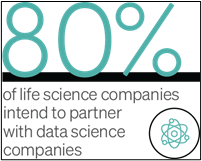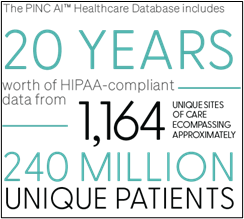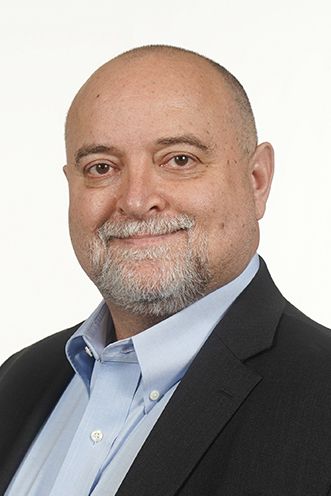It’s 2022. Which Database is Informing Your Real-World Evidence?

Key takeaways:
- Understand the components of a charge master database and a claims database.
- Understand the PINC AI™ Healthcare Database (PHD) and its components.
- Review case studies where data was used to expand use and improve research, quality and patient outcomes.
For more on this topic:
- Learn more about how you can use PINC AI™ Healthcare Data to conduct evidence-based analyses of drugs, devices and disease states and accelerate medical solution development.
Life science companies have been exploring the use of real-world evidence (RWE) based on real-world data (RWD) to help reduce expenses, time frames and complexities associated with bringing a medical solution to market. Thanks to the 21st Century Cures Act, more regulatory agencies are recognizing the promise of RWD. When combined with clinical trial research, it can shorten the regulatory approval process and increase the chances of U.S. Food and Drug Administration (FDA) and European Union Medical Device Regulation approvals.
However, RWD is complicated and life science companies need access to huge volumes of standardized datasets on patients, disease states, demographics and comparative findings – which is why more than 80 percent of them stated their intent to enter into partnerships with data science companies this year. Partnering with the right company helps life science organizations achieve real-world action by connecting them with multiple health systems and patients through data and scalable solutions.

Having the ability to act on the data by turning it into provider-level actions that benefit patients is critical to the success of these partnerships
Even with a partnership, how does one know which database will provide the right data to answer the research question?
What is a charge master database?
The American Health Information Management Association (AHIMA) defines a charge master database (CDM) as “the database of all billable items that go on patients’ accounts.” This encompasses all items related to patient care during inpatient visits, emergency department visits, health system clinic visits and same day surgery visits that could produce a charge ranging from all procedures and services provided by the health system personnel and the supplies, devices, products and drugs charged during those visits.
The information available will include the types and brand names, when available, a list of the supplies, devices, products and any medications charged with brand, dosage, and route of administration during a visit.
This type of data gives researchers insight into every intervention that was used, allowing them to learn more about patient outcomes and the associated costs with specific drug utilization, including drugs used in health systems and those administered in infusion clinics.
This level of detail is critical for life science companies when they are looking at comparative effectiveness, burden of illness or want to demonstrate a drug or device benefit on total cost of care and outcomes. CDM data can provide the actionable information necessary to help affirm a life science companies’ solution is worth the price that they’ve come to market with, and proves that it can reduce readmissions, length of stay or other important outcomes.
What is a claims database?
A claims database contains all data provided from a processed healthcare claim. Claims data can be sourced from payers (commonly known as a closed claims database) or from practice management systems/clearinghouses (open claims database).
Claims data consists of the billing codes that physicians, pharmacies, health systems and other healthcare providers submit to payers (e.g., insurance companies, Medicare) for payment purposes.
Due to the nature of data submission by providers, the information within a claims database can be limited, meaning the claim reflects only the diagnoses and services that were coded or occurred on the date when the claim was submitted. An individual claim is not designed to convey information about what happened in the past and limits visibility into resource utilization.
It will include the procedures and diagnosis codes as necessary for billing; however, there will be limitations on the number of codes submitted and visibility into the details of the supplies/devices/medications charged during the claim. Additionally, not all elements of a patient encounter are captured in an insurance claim. Much of what takes place in a health system or clinic is not reimbursed by insurance, and therefore, that detail is left out. For example, if the episode of care is covered under a diagnosis-related group (DRG), the claim will only reflect high-level, generic information.
How can you use charge master data to drive smarter healthcare?
Let’s look at three ways life science companies can utilize RWD/RWE derived from charge master data to confirm their product’s proof of value and ability to improve patient outcomes, expand use, lower costs and reduce healthcare utilization.
1. Comparative Effectiveness Analysis
Clinical researchers are always seeking to answer, “what works best?” They have utilized comparative effectiveness research(CER) to determine which treatment is most effective for whom, and under what circumstances. CER is research that identifies what clinical and public health interventions have the best outcomes for improving health and which interventions pose the greatest benefit and least risk for populations.
One life science company wanted to better understand the benefits to patients of their Spinal Cord Stimulation (SCS)/Pain Management platform and generated RWD/RWE to expand its use.
They began by conducting data analysis to generate RWE based on RWD to identify patients that could benefit from customized back pain therapy. Their goals were to understand current evidence-based care pathways for the chronic back pain population and evaluate the efficacy of their own SCS platform for expansion of use among chronic back pain sufferers.
Together with the PINC AI™ Applied Sciences (PAS) team, the life science company utilized the PHD to inform their efforts to expand the use of their SCS platform by understanding their platform’s impact on patient outcomes, impact on cost of care and how it compared to competitor platforms. As a result, the life science company was able to receive a standardized dataset that helped them conclude and affirm through the use of their SCS platform they could reduce utilization of emergency department (ED) visits for back pain at a lower cost than their competitors. This type of real-world analysis can save time and money compared to traditional clinical trials and gets the newest innovations to patients more rapidly.
2. Intervention Market Expansion
In many clinical conditions, earlier diagnosis provides an opportunity for life science companies’ products to be leveraged earlier in the treatment process resulting in improved outcomes, lower cost and hope for those who suffer from debilitating diseases.
For example, peripheral artery disease (PAD) is associated with a high mortality rate, typically diagnosed later in progression, and according to the American Heart Association, is rising in prevalence with approximately 6.5 million people aged 40 years and older in the U.S. suffering from PAD.
Despite its prevalence and increased risk of death and ischemic events, PAD has been understudied, underdiagnosed and undertreated in the U.S. and around the world.
With heart disease costs that include healthcare services, medicines and lost productivity due to death, in the U.S. at approximately $363 billion each year from 2016 to 2017, there is great benefit to be achieved through early diagnosis and the expansion of peripheral interventions or drug eluting technologies.
This spurred one life science company to use real-world data to identify and study patients at high risk of developing PAD. They sought to develop more informed strategies that would prompt clinicians to detect PAD earlier and provide patient education to help them recognize and report early signs and symptoms of PAD.
Together with the PAS team, they worked to identify patients from the population dataset that had any known risk factors or symptoms of PAD but were not coded with a PAD diagnosis.
The PHD, which held clinical data points not included in a claims database, allowed them to review the populations’ ED and health system clinic visits in which PAD risk factors were documented and charged including:
- Diabetes
- BMI<30
- Hypertension
- Hypercholesterolemia
- Age 50+
- Smoker
- Family history
- ABI testing
- Unexplained leg pain/cramping
The life science company evaluated this standardized dataset to inform, develop and implement scalable clinical processes for early diagnosis, intervention and treatment. This meant that patients within the population who presented with any of these risk factors and had not been diagnosed with PAD could be targeted for intervention and early treatment utilizing peripheral interventions or drug-eluting technology for the greatest patient benefit.
3. Burden of Illness
Burden of illness (BOI) research, also called cost-of-illness studies, is designed to estimate the economic impact of a particular disease or illness on a population in monetary terms. It also captures the disease or illness’s effect on longevity and morbidity along with an individual’s decrease in health status and quality of life. Often, this is referred to “total cost of care.”
One life science company was conducting data analysis to better understand the burden of chronic obstructive pulmonary disorder (COPD) and annual cost of treatment in both emergency and acute care settings. They aimed to identify specific drivers of cost such as radiology, laboratory and microbiology diagnostic tests as well as medications, respiratory therapy, mechanical ventilation and intensive care.
Together with the PAS team, the life science company utilized the PHD to better understand the cost of treating exacerbations of COPD that required emergency or acute care over a one-year period.
As a result, the life science company was able to receive a standardized dataset that helped them conclude and affirm that, through the use of their novel inhaler, which had been clinically proven to reduce exacerbations of COPD, they were able to reduce cost of care through a decrease in incidence of COPD exacerbations requiring emergency or acute care.
Is the PINC AI™ Healthcare Database a charge master database?
The PINC AI™ Healthcare Database (PHD) is a HIPAA-compliant retrospective database filled with more than 20 years’ worth of charge master data that includes cost, charge and outcomes data from 1,164 unique sites of care, spanning the continuum of care and encompassing visits from approximately 240 million unique patients.

In a recent webinar, Premier’s Myla Maloney, Chief Commercial Officer, PINC AI™ Applied Sciences, spoke with Megan Billingsley about the importance of charge master data and how to achieve better research and patient insights.
The PHD includes information on health system-based inpatient and outpatient visits, ambulatory visits and medication/device utilization as well as different types of coverage from cash to commercial payer, to Medicare and Medicaid.
This robust, geographically diverse dataset is routinely used to help life science companies and health systems conduct clinical, financial and outcomes-based analyses on drugs, devices, treatments, disease states, epidemiology, resource utilization and healthcare economics.
Moving Forward
These real-life research scenarios aren’t the only three ways in which life science companies have used RWD/RWE, but they do share how impactful integrated data can be when launching a new drug or device, proving value, driving clinician behavior change and positioning a medical solution in the market.
However, data has its challenges including cost, access and how to connect the RWD/RWE and turn it from information into actionable ideas.
This expensive and time intensive process of data acquisition makes finding the right data partner critical. You need to be able to work together seamlessly to connect data points, break down data silos, streamline research and speed up solution time to market.
Learn how you can partner with PAS and make PINC AI™ Healthcare Data part of your research and product development strategy.
The insights you need to stay ahead in healthcare: Subscribe to Premier’s Power Rankings newsletter and get our experts’ original content delivered to your inbox once a month.

With more than 21 years of industry experience, Myla leads Premier Applied Sciences healthcare transformation efforts through partnerships with life sciences, biopharmaceutical and medical device companies aimed at improving the quality of patient care.

John has more than 20 years of research experience with expertise in biostatistics and information technology. He has been with Premier since 2015.

Jim investigates life science questions by exploring the Premier Healthcare Data and designing studies that produce real-world evidence. As a problem solver, Sianis applies his combined clinical experience and outcomes measurement expertise to help solve clinical and business needs for a variety of healthcare organizations.

Anne leads real-world data optimization efforts for the Premier Applied Sciences team. She collaborates with life sciences companies and partners to understand their real-world data needs and supports them in utilizing Premier Healthcare Data to perform prescriptive analyses.
Article Information

With more than 21 years of industry experience, Myla leads Premier Applied Sciences healthcare transformation efforts through partnerships with life sciences, biopharmaceutical and medical device companies aimed at improving the quality of patient care.

John has more than 20 years of research experience with expertise in biostatistics and information technology. He has been with Premier since 2015.

Jim investigates life science questions by exploring the Premier Healthcare Data and designing studies that produce real-world evidence. As a problem solver, Sianis applies his combined clinical experience and outcomes measurement expertise to help solve clinical and business needs for a variety of healthcare organizations.

Anne leads real-world data optimization efforts for the Premier Applied Sciences team. She collaborates with life sciences companies and partners to understand their real-world data needs and supports them in utilizing Premier Healthcare Data to perform prescriptive analyses.